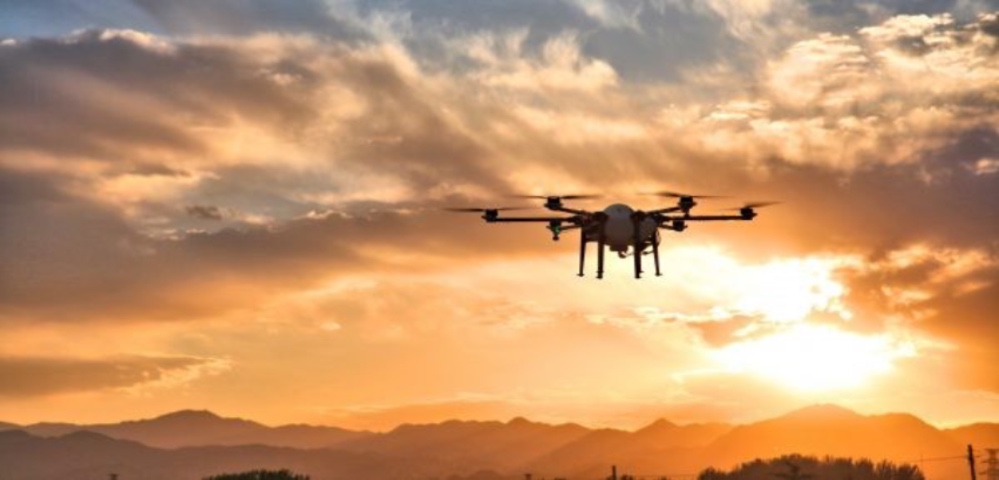Drone technology
On using drones, farmers report on average a 10 to 15% increase in productivity, owing to timely spraying.Many farmers are now planning to expand their cropping area, knowing that labor availability is no longer achallenge.
Alfred Quaynor, Chief Enabling Officer, AB Precision SolutionsBACKGROUND
In Ghana, smallholder farmers with an average farm size of one hectare can take half a day to apply agrochemicals. Manual application also has adverse health implications for inexperienced sprayers.Drone spraying takes only 20 minutes on one hectare, compared with three hours by knapsack. It preservesthe farmers and their communities’ health.
WHAT’S INVOLVED
Field demonstrations: Farmers access information about the drones through educational forums and demonstrations that thecompany initiates for farmer-based organizations. They hire drones in groups, for greater efficiency.
Saving of time and improved safety for farmers: Apart from saving time, drones involve less damage to crops, they spray more evenly than knapsacks, farmers do not come into contact with the chemicals, and the company always goes with the agronomist to show farmers best practice on how to use the agro chemical.
EXPLORE THIS SOLUTION
The use of drones on smallholder farms offers:
- time saved allowing farmers to pursue other tasks. Children in particular are freed up to focus on school, reducing child labor practices.
- reduced exposure to chemicals that are harmful when handled inappropriately.
- Reduced crop damage during spraying, since no one is walking in the field and applying chemicals.
- Cautionary note: For drones to be cost effective, farmers need to organize themselves so that the drone can spray over severalfarms in one operation.

Countries involved
Ghana
Project partners
AGRA, Farmer Globale, Hopeline Institute
Project dates
2019 – present
Share this solution
Bookmark this solution
BookmarkShow Full Solution
Summary
Most farmers have a problem with on time application of pesticide sprays owing tothe lack of knowledge on how to scout for pests, how to determine the optimaltime to spray, and a shortage of labor during certain periods of the cropping cycle. The use of drones increases spraying efficiency and reduces the turnaround times for applying crop protection.
The Challenge/Problem
In Ghana, smallholder farmers who have an average one-hectare farm size cantake half a day to apply crop protection on their fields. Once their crops are sprayed,farmers have to wait two days to monitor the effectiveness of their spraying, and then decide whether they need to re-spray. Knapsacks are often poorly calibrated and fields are often unevenly sprayed, leaving gaps in pesticide coverage of thecrops. This can lead to secondary pest infestation necessitating respraying to prevent crop losses.
This increases the cost of production, lowers yields and increases labor costs. Furthermore, much of the manual spraying labor is provided by children, who should be in school and proscribed from handling pesticides, especially given thatmost sprayers do not wear adequate personal protection equipment (PPEs).
Solution
One solution being put to good use in Ghana is drone technology. ABPrecision Solutions, a company providing drones for spray services in Ghana, hasmade the technology affordable by matching the cost of drone spraying to the cost of knapsack spraying. Farmers access information about the drone spraying servicethrough educational forums and demonstrations organized for farmer groups andfarmer-based organizations.
On average, the cost of spraying with a drone is about US$12.0 per hectare, which isthe same as for knapsack spraying. However, the use of drones benefits fromeconomies of scale by enabling farmers to cover larger areas per day than is possible with ground- based knapsacks. The solution has the following advantages:
- Saving of time: Drone spraying takes only 20 minutes per hectare, com- pared with three hours by a team of six sprayers with knapsacks.
- Less damage to crops: Since no sprayers enter and walk the fields, there is no physical crop damage as is often experienced with knapsack spraying.
- Efficiency: Drones spray much more evenly than knapsacks, so there is no need for repeat sprays.
- Health: Farmers do not come into contact with the chemicals, thereby pre- serving their health.
A recent business development is that AB Solutions has introduced a credit scheme that enables farmers topay for drone spraying in exchange for their farm produce. This provides farmers with a ready marketfor their crops while also limiting post harvest losses amongst their customers.This project has been undertaken with the support of AGRA and the Hopeline Institute in Ghana.
Results
The solution is currently implemented in the southern and middle belts of Ghana, and plans are in place to expand the service to the Eastern Region of Ghana. There have also been calls from the north of the country from interested farmers.
Farmers who contract the drones report on average a 10 to 15% increase in productivity, owing to timelyspraying. Further, because crop protection has become quick and easy, many farmers are planning to expand their cropping area, knowing that labor availability is no longer a limiting factor on how large an area they can plant.
A drone is capable of spraying one hectare in fifteen minutes, against three hours by a team of aboutsix knapsack sprayers. The farmer now has time to attend to other pressing needs on his/her farm, instead of standing by for three hours simply supervising the spraying. Furthermore, children are freed up to focus on school.
Lessons Learned/Potential for replication
- For the solution to be cost effective farmers need to be coordinated to grow similar crops at aroundthe same time of year so that AB’s drones can spray over several farms in a single operation. To facilitate this coordination, AB Solutions partners with farmer-based organizations.
- Awareness needs to be raised amongst farmers on the benefits of using drones compared to knapsack spraying. Practical demonstrations have proven immensely helpful in getting farmers to recognize the benefits of drones.
- When spraying is uncoordinated and crops are in different growing stages, overspray and winddrafts can blow chemicals onto neighboring plots that do not require protection at that time, adversely affecting crops neighboring crops, wasting pesticide and causing farmer distress.
- Drone operators can be selected from amongst knapsack sprayers thereby building local capacity and creating new jobs.
Next Steps
Drone spraying and monitoring works best for small and medium scale farmers when there is planning and coordination among the farmers. It is easier to work with organized farmer-based organizations to help farmers coordinate and plan. Because farmers are paying for the service, either through cash or produce, the business issustainable.For more effective spraying, the company aims to acquire more drones, a pick up truck, and grow the number of spray teams to meet the growing demand for their services.
Solution Additional Resources
AB PrecisionLast update: 25/05/2021


